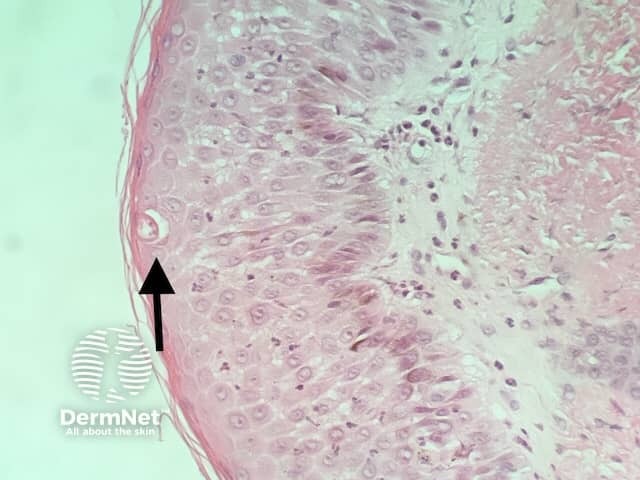Main menu
Common skin conditions

NEWS
Join DermNet PRO
Read more
Quick links
Cutaneous larva migrans pathology — extra information
Infestations Diagnosis and testing
Cutaneous larva migrans pathology
Author: Adjunct A/Prof Patrick Emanuel, Dermatopathologist, Clinica Ricardo Palma, Lima, Peru. DermNet Editor-in-chief: Adjunct A/Prof Amanda Oakley. July 2018.
Introduction
Histology
Special studies
Differential diagnosis
Introduction
Cutaneous larva migrans is a parasitic skin infection caused by helminth larvae that usually infest cats, dogs and other animals. Humans can be infected with the larvae by walking barefoot on sandy beaches or contacting moist soft soil that have been contaminated with animal faeces. It is also known as creeping eruption, as once infected, the larvae migrate under the skin's surface and cause itchy red lines or tracks.
Histology of cutaneous larva migrans
In larva migrans, histopathologic examination shows curvilinear eosinophilic larvae within the epidermis (figures 1,2, arrow). The larvae may be seen in the superficial epidermis (as in this case illustrated) or deeper in the superficial dermis. There may be an inflammatory reaction rich in eosinophils.

Figure 1

Figure 2
Special studies for cutaneous larva migrans
None are generally needed. Consultation with colleagues in microbiology can be helpful in unusual cases.
Differential diagnosis for cutaneous larva migrans
Infestation with scabies, superficial fungal infections and deeper infestations can usually be readily distinguished on clinical grounds.
References
- Textbook of Dermatology. Ed Rook A, Wilkinson DS, Ebling FJB, Champion RH, Burton JL. Fourth edition. Blackwell Scientific Publications.
- Caumes E. Treatment of cutaneous larva migrans. Clin Infect Dis. 2000 May;30(5):811–4. Review. Medline
- Soriano LF, Piansay-Soriano ME. Treatment of cutaneous larva migrans with a single session of carbon dioxide laser: a study of ten cases in the Philippines. J Cosmet Dermatol. 2017 Mar;16(1):91–4. doi: 10.1111/jocd.12296. Epub 2016 Nov 29. PubMed PMID: 27900835. PubMed.
On DermNet
- Arthropod infestations online course for health professionals
- Cutaneous larva migrans
- Hookworms
- Gnathostomiasis
- Dermatopathology glossary
- Dermatopathology index
Other websites
- Cutaneous Larvae Migrans — Medscape Reference
